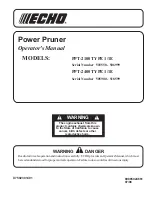
Turn the upper blade pulley (8) several times in a
clockwise direction.
Check the setting of the guide pins (28) again
and re-adjust if necessary.
7.4.4. Adjusting the lower guide pins (29)
Dismantle the saw table (15).
Undo the screw (40).
Move the mount (49) of the guide pins (29) so
that there is a gap of approx. 1 mm between the
front edge of the guide pins (29) and the gullet of
the blade in front.
Re-tighten the Allen screw (40).
CAUTION!
The blade will be rendered useless if
the teeth touch the guide pins while the blade is
running.
Re-tighten the Allen screws (38).
Move the guide pins (29) towards the blade so
that there is a gap of approx. 0.5 mm between
the guide pins (29) and the blade (26). The blade
must not jam.
Re-tighten the Allen screws (38).
Turn the lower blade pulley (7) several times in a
clockwise direction.
Check the setting of the guide pins (29) again
and re-adjust if necessary.
CAUTION! When the adjustments have been
finished, the blade guard (34) must be closed
again.
7.5. Adjusting the upper blade guide (11) (Figure 11)
Undo the fixing handle (20).
Turn the setting wheel (19) to lower the blade
guide (11) as close as possible to the workpiece
to be cut. The gap should be approx. 2-3 mm.
Re-tighten the fixing handle (20).
Check the setting before each cut and re-adjust if
necessary.
7.6. Adjusting the machine table (15) to 90° (12/13)
Move the upper blade guide (11) to the top.
Undo the fixing handles (18).
Set the angle between the blade (26) and the
table (15).
Turn the setting wheel (19) to tilt the saw table
(15) until it is at an angle of exactly 90° to the
blade (26).
Re-tighten the fixing handle (18).
Undo the nut (42).
Adjust the Allen screw (41) until there is contact
with the machine frame.
Re-tighten the nut (42) to fasten the Allen screw
(41).
Undo the recessed head screw (e) to position the
arrow (17) on the 0° mark on the dial scale (16).
7.7. Blade selection
The blade supplied with the bandsaw is designed for
all-purpose use. When you select a blade you should
have regard to the following criteria:
Use a narrow blade to cut tighter radii than you
can with a wider blade.
Wide blades are used to saw straight cuts. This
is particularly important in cutting wood because
the blade has a tendency to follow the grain of
the wood and thereby deviate easily from the
cutting line.
Finely toothed blades provide smoother cuts but
are slower than coarse blades.
Important: Never use warped or
lacerated blades!
7.8. Changing the blade (Fig. 14)
Move the blade guide (11) into a position
approximately half way between the saw table
(15) and the machine housing (25).
Undo the fasteners (13) and open the side cover
(12).
Remove the web panel (4).
Turn the tightening screw (9) anti-clockwise to
remove the tension from the blade (26).
Remove the blade (26) from the blade pulleys (7,
8) and take out through the slot in the table (15).
Fit the new blade (26), aligned centrally on the
blade pulleys (7, 8).
The teeth of the blade (26) must point
downwards in the direction of the table.
Tension the blade (26) (see 7.2)
Close the side cover (12) again.
Mount the web panel (4) again.
7.9. Changing the rubber tires on the blade pulleys
(Figure 15)
After a certain time the rubber tires (3) on the blade
pulleys (7/8) will get worn by the sharp teeth of the
blades and must be replaced.
Open the side cover (12).
Remove the blade (26) (see 7.7).
Lift the edge of the tire (3) with a small
screwdriver (f) and remove from the blade pulley
(8).
Repeat for the lower blade pulley (7).
GB
20
Anleitung BM 200 SPK 1 14.03.2005 16:37 Uhr Seite 20
















































